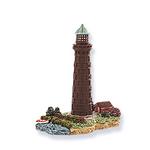Add Product Review
Tell us what you think about this item and share your experience with others. Please include only information that is relevant to the item you are reviewing.
Bolivar, Texas

The "This Little Light of Mine" series by Harbour Lights are miniature versions of the Harbor Light's lighthouses.
History of the Lighthouse:
On February 3, 1845, the Republic of Texas earmarked $7,000 for the establishment of a lighthouse on the eastern end of Galveston Island. However, before significant progress was made, the United Sates annexed Texas, and the federal government assumed responsibility for navigational aids in Texas. Wasting little time, Congress set aside $15,000 in 1847 for the construction of lighthouses at Galveston and at Matagorda Bay.
The proposed site for the lighthouse was moved from Fort Point on the eastern end of Galveston Island to Bolivar Point, located on the opposite side of the entrance to Galveston Bay, at the western end of the Bolivar Peninsula. Protracted negotiations with the landowner coupled with delays by the Texas government in ceding jurisdiction over the site postponed work on the lighthouse until the fall of 1851. In the meantime, a lightship was deployed at the Galveston bar, marking this most important Texas port.
The iron sections for the 65-foot tower were cast in Baltimore by Murray and Hazlehurst, shipped west, and then erected at Bolivar Point. The keeper’s dwelling was completed in April of 1852, but work continued on the tower until October. Lamps and twenty-one inch reflectors were installed in the tower by Christmas Day, and the light commenced operation shortly thereafter.
During its first year of service, the district lighthouse engineer petitioned for a brighter light and additional iron sections to elevate the light. Complaints were also voiced by the harbor pilots, prompting the Lighthouse Board to supply a third-order Fresnel lens and an additional twenty-four feet of sections for the tower. The modifications to the tower were completed by the summer of 1858.
Just three years later, Texas joined the other southern states in seceding from the Union. Most of the southern lighthouses were darkened during the Civil War, but the Bolivar Point Lighthouse was completely dismantled. Given the dramatic cost increase for iron during the war and the fact that no piece of the original tower has ever been discovered, it is assumed that the iron sections were used as armor plating for ships or were melted down to produce military armaments.
After the war, a temporary 34-foot, wooden tower was hastily established near the site of the original lighthouse. The light from the tower’s fourth-order Fresnel lens was activated on August 5, 1865. On July 15, 1870, Congress appropriated $40,000 for the construction of a second iron tower on the point. The Lighthouse Board decided to pattern the new station after the one at Louisiana’s Pass a l’Outre, which consisted of a 117-foot iron tower and a wooden keeper’s dwelling. The tower was provided by Bailey and Debevoise of New York City for the sum of $25,850, while William F. Crow and Company of Galveston were contracted to provide the dwelling. The lamp in the station’s third-order Fresnel lens was first lit for mariners on November 19, 1872. The tower had been painted with black and white horizontal bands to provide a distinctive daymark.
Mariners soon complained that the new beacon was not as bright as the original 1852 light. The district engineer concluded that the lens was defective, reporting that it had “little or no magnifying power and has a smoky cast or appearance.” The anchor lights of the vessels in the harbor were reportedly more brilliant than the lighthouse, and a powerful second-order lens was ordered to remedy the problem.
The effectiveness of the tower’s light wasn’t the only problem at the station, as the keeper and his assistant were accusing each other of negligence and impropriety. Assistant keeper Edson C. Brace complained that keeper Horace W. Crockett was “an irascible, drunken, partly-demented man,” who had threatened physical violence, while Crockett charged that Brace of failing to maintain a proper light and exposing himself to a passing train. District Inspector arrived to investigate the situation, and soon Brace has resigned and Crockett retired to operate a store he owned in Port Bolivar.
Harry C. Claiborne, known as the best keeper in the district, was appointed keeper at Bolivar Point to replace the problematic pair of keepers. Claiborne began his twenty-four years of service at the Bolivar Point Lighthouse on December 15, 1894, transferring from the lighthouse’s twin at Pass a l’Outre. Describing the couple’s existence at the station, Claiborne’s wife remarked: “Life at the lighthouse was very lonely and friendless. There is very little visiting because travel is nonexistent from the point to Galveston. We pass most of our time by reading books.” While her description surely applied to most of their stay at the lighthouse, it certainly wasn’t the case when hurricanes struck Galveston in 1900 and 1915.
The Great Hurricane of 1900 inundated Galveston Island with five feet of water, destroying much of the city and causing the death of nearly 6,000 people. During the height of the storm, which occurred during the evening of September 8, over 120 people sought protection in the iron lighthouse. Seated by twos on the tower’s spiral staircase, the refugees huddled together as 120-mile-per-hour winds rocked the tower. After the floodwater receded from the base of the tower, the occupants exited the lighthouse to discover the bodies of a dozen people, who were unable to reach the safety of the tower. The Claibornes fed the hungry crowd using their lighthouse rations, which were quickly depleted.
A similar scene played out during the hurricane of August 16-17 1915, when sixty people were forced to seek protection on the tower’s spiral staircase. Assistant keeper J. P. Books, who stood watch in the lantern room during part of the storm, reported that the top of the tower “shook and swayed in the wind like a giant reed.” The mechanism used to rotate the lens broke down, forcing Books to rotate the lens by hand. The damage inflicted on the station by this storm was more severe than that of 1900. The two keeper’s dwellings were destroyed, and the oil house and other outbuildings were washed away. After exhausting the supply of oil kept in the tower, the light went dark until a new shipment of oil reached the station.
When the station’s new dwellings were built, they were wisely placed on pilings to keep them above any future storm surge. In honor of keeper Claiborne’s years of faithful service at Bolivar Point, the Coast Guard named one of its 175-foot buoy tenders the Harry Claiborne. Appropriately, the buoy tender is stationed in Galveston.
As plans developed for the Galveston Jetty Lighthouse, the signature of the Bolivar Point Lighthouse was changed in 1907 from a fixed, second-order light, to a flashing, third-order light. After numerous delays, the jetty light became operational in 1918. When its candlepower was increased in 1930, the Lighthouse Commissioner recommended discontinuing the Bolivar Point Lighthouse. Public outcry prolonged the life of the lighthouse, but three years later, with the Lighthouse Service feeling the effects of the depression, the iron tower went dark.
In 1947, the lighthouse was sold to E.V. Boyt for $5,500, and it has remained in the family every since. Though the tower is off-limits to the public, the tower’s third-order Fresnel lens can be seen at the Smithsonian's National Museum of American History in Washington D.C.






